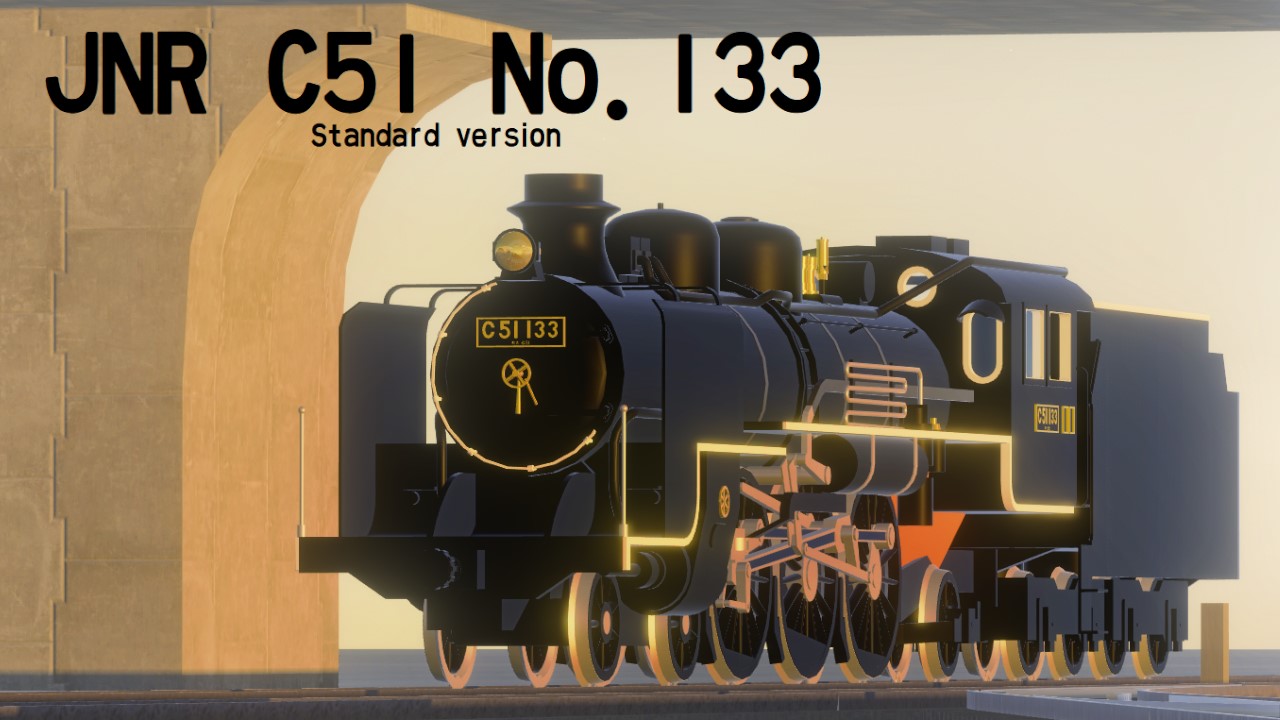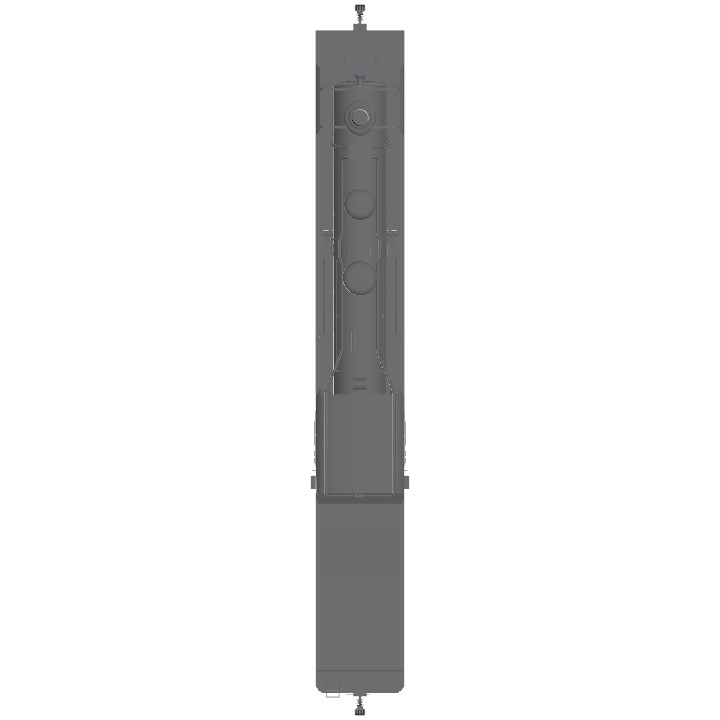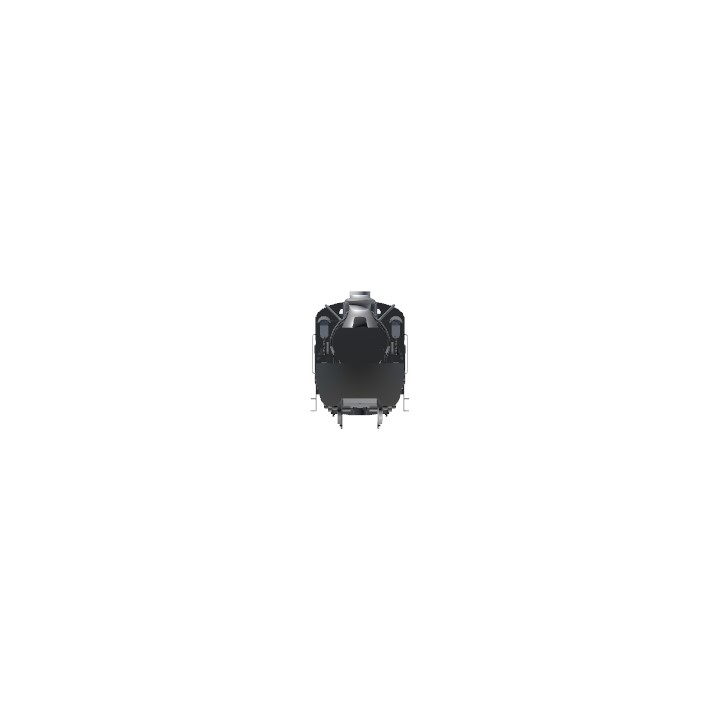Attention
This work is a vehicle for SPR. However, while the SPR is built with a rail width of 1435mm, all Japanese steam locomotives are built with a rail width of 1067mm. Therefore, if the locomotive is adapted to the SPR, the overall width becomes wider, and the body of the locomotive touches the station building. Therefore, the locomotives can only be operated on a part of the SPR tracks (although they can be operated on most of the tracks between stations).
Control
AG1+VTOL : Move forward and back
Brake : Brake
AG2 : Turn on the light
AG3 : Activate coupler(magnet)
History
JNR C51 No.133 was built in October 1923 as train No. 18900 28932 at the Osaka Works of the Railway Company. Later, it was renamed C51 No.133 in accordance with the 1928 revision of the naming regulations.
At the end of January 1931, No.133 underwent a test modification at Nagoya to extend the smoke chamber by 800 mm. After undergoing a series of tests, it was restored to its original form in 1934.

C51 No.133 and C51 No.246
After that, No.133 survived the Pacific War in Sendai and other engine works, and moved to Fukushima engine works in 1945.
Later, in 1949, No.133 was wrecked in the Matsukawa Incident described below, and the car was placed in mothballs that year, scrapped the following year in 1950, and dismantled in 1951.
Matsukawa Incident
At around 3:09 a.m. on August 17, 1949 (originally 2:09 a.m. because the Allied Occupation Daylight Saving Time was in effect at that time), a passenger train pulled by No. 133 suddenly derailed and overturned between Kanayagawa and Matsukawa stations on the Tohoku Main Line, killing three people, one engineer and two assistant engineers.
Derailed and overturned No.133
On-site inspections confirmed that bolts and nuts at the track joints near the overturned point had been loosened and the joint plates had been removed. In addition, many of the dog nails that secure the rails to the sleepers had been removed, and one rail, 25 meters long and weighing 925 kg, had been removed and moved 13 meters, leaving it almost straight. A search of the area revealed a crowbar and a wrench each in a nearby paddy field.
At the time, Japan was experiencing major railway-related incidents such as the Shimoyama Incident, in which the president of Japan National Railways was found dead after being run over, and the Mitaka Incident, in which 26 people were killed or injured when an unmanned train ran out of control inside Mitaka Station. In addition, JNR was undergoing a large-scale restructuring at the time of the incident, and a total of 20 people were arrested on suspicion of organized crime by the labor unions of Toshiba's Matsukawa Works and JNR, which were opposed to the restructuring.
However, all 20 of those arrested were only able to confess to their crimes under torture from investigators who assumed that the case was "committed by trade unionists," and all were acquitted during the 14-year trial that followed.
Since this incident was artificially caused, the real culprit must have been somewhere. However, the statute of limitations expired without catching the real culprit before the 20 defendants were acquitted in the trial, and the case became an unsolved case.
There are several hypotheses about the truth of this case, but the most popular theory is that it was a plot by GHQ, the police, and others as part of the Red Purge to suppress the labor movement of Toshiba employees and others who supported the Japanese Communist Party. This theory is based on the suspicious activities of the police station personnel, who may have cooperated in helping the perpetrators escape to safety despite numerous eyewitness reports, the suspension of freight trains passing by the accident site just before the accident, the police's too-early arrival at the scene, and the confession by torture mentioned above. However, none of these theories lacks conclusive evidence, and cannot be declared true.
The Matsukawa Incident, which ended in this way, is still talked about today as one of the three major unsolved cases of JNR, together with the Shimoyama Incident and the Mitaka Incident.

Cenotaph
Gallery


HAVE FUN!!!
Specifications
Spotlights
- ShiroNeko 1.4 years ago
General Characteristics
- Predecessor JNR C51 No.133 long smoke box
- Successors 1 airplane(s) +14 bonus
- Created On Windows
- Wingspan 12.1ft (3.7m)
- Length 88.5ft (27.0m)
- Height 16.9ft (5.2m)
- Empty Weight 99,277lbs (45,031kg)
- Loaded Weight 103,292lbs (46,852kg)
Performance
- Wing Loading N/A
- Wing Area 0.0ft2 (0.0m2)
- Drag Points 26081
Parts
- Number of Parts 1519
- Control Surfaces 0
- Performance Cost 4,949





hehe tren
SimpleTrains
My God, she's beautiful.